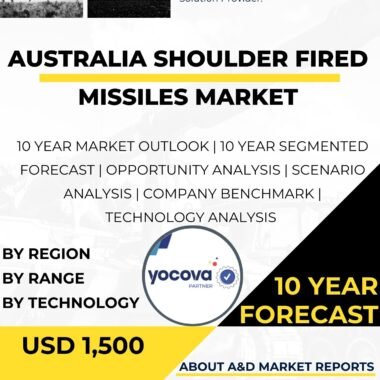Description
The shoulder-fired missiles market in Japan has experienced significant growth and strategic importance as the nation focuses on enhancing its defense capabilities, modernizing its infantry forces, and countering potential threats in the region. Shoulder-fired missiles, also known as man-portable anti-tank guided missiles (ATGMs), are essential weapons that provide infantry units with increased firepower and anti-armor capabilities. As Japan seeks to bolster its military readiness and response capabilities, the demand for advanced shoulder-fired missiles has grown, leading to increased research, development, and investment in this field.
The shoulder-fired missiles market in Japan encompasses a wide range of ATGM systems, including wire-guided and wireless command-link missiles. These missiles are designed to be lightweight and portable, enabling infantry soldiers to carry and operate them effectively on the battlefield.
One of the primary applications of shoulder-fired missiles in Japan is in infantry anti-armor warfare. ATGMs provide infantry units with the capability to engage and destroy enemy armored vehicles, including tanks and armored personnel carriers, at extended ranges. The ability to neutralize enemy armor is crucial for Japan’s defense strategy, considering the region’s evolving security environment.
Moreover, shoulder-fired missiles play a crucial role in Japan’s defense against potential amphibious threats. Japan’s geographic location, surrounded by water, necessitates a strong maritime defense capability. Shoulder-fired missiles equipped with anti-ship capabilities can be used by coastal defense units to engage hostile maritime targets and enhance Japan’s maritime security.
Additionally, ATGMs contribute to Japan’s counter-insurgency and counter-terrorism operations. These missiles can be employed in asymmetric warfare scenarios to engage fortified positions, eliminate enemy bunkers, and disrupt enemy operations effectively.
As Japan emphasizes indigenous defense capabilities, the domestic production and development of shoulder-fired missiles have seen substantial growth. Collaborations between the government, defense industry, and research institutions have fostered innovation, leading to the creation of advanced shoulder-fired missile systems tailored to Japan’s specific defense requirements.
Japan’s alliance with the United States has also played a significant role in the development of its shoulder-fired missile capabilities. Through this partnership, Japan has access to advanced missile technologies, expertise, and support, contributing to the modernization of its infantry forces and enhancing interoperability with allied nations.
The shoulder-fired missiles market in Japan also benefits from advancements in missile guidance systems, warhead technology, and improved ergonomics. Manufacturers have leveraged these developments to create ATGMs with enhanced target acquisition capabilities, increased penetration power, and improved ease of use for infantry soldiers.
However, the shoulder-fired missiles market in Japan also faces challenges related to cost, export restrictions, and technological competition. Developing and maintaining advanced missile systems can be costly, requiring significant investment in research, development, production, and training.
Addressing export restrictions on sensitive military technologies can impact Japan’s ability to collaborate with international partners and access critical technologies for missile development.
Moreover, Japan faces competition from other regional players and global defense industries in the shoulder-fired missiles market. Ensuring that Japan’s domestic missile systems remain cutting-edge and competitive is crucial for maintaining technological superiority and market relevance.
In conclusion, the shoulder-fired missiles market in Japan has witnessed significant growth and strategic importance, driven by the nation’s focus on enhancing its defense capabilities, modernizing its infantry forces, and countering potential threats in the region. Shoulder-fired missiles provide critical capabilities for infantry anti-armor warfare, maritime defense, and counter-insurgency operations, making them integral to Japan’s defense strategy. The collaboration between the government, defense industry, and research institutions, as well as international partnerships with allied nations, fosters innovation and contributes to the growth of the domestic shoulder-fired missiles market. Addressing challenges related to cost, export restrictions, and technological competition is crucial for further enhancing Japan’s shoulder-fired missile capabilities and ensuring that the nation’s infantry forces remain equipped with advanced and reliable shoulder-fired missiles to effectively respond to evolving security threats and maintain regional stability. With its strategic focus on enhancing indigenous defense capabilities, Japan remains committed to leveraging advanced shoulder-fired missile technologies to enhance its defense capabilities and contribute to regional and global security.




